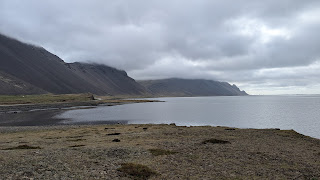Last evening I could get my washing done too. However, when I tried to make the payment over the link given in the washing area, I couldn't connect with any of my cards. I could not meet the hosts before I left for Egilsstadr, but I promised to get through to her sometime during the day to find out how I could make the payment.
Leaving the pretty lobster capital town of Hofn I had the jagged Vestahorn mountain range on my left. After the amazing road tour from Reykjavik to Vik and onwards to Hofn on the southern and southeastern leg of the Nordic Escapade I did not expect much from the road trip to Eastern Iceland. But I was proved wrong at every turn of the road. It turned out to be one of the most picturesque drives on my travels abroad. The pristine and unspoilt countryside with the magnificent mountain range on one side and the blue waters of the Ocean on the other reminded me a lot of the drive in New Zealand. I truly relished the scenery that unfolded in the drive between Hofn and Egilsstadr.The craggy outline that belongs to the mountain Vestrahorn rises dramatically behind a broad swath of sand littered with clumps of grass. Rising to a height of 454 meters, this rocky outcrop is formed mostly from gabbro, a coarse-grained igneous rock created when the magma cools slowly.The East Icelandic mountains are home to herds of reindeer, a special breed introduced centuries ago from the Lapland. Both sexes have antlers, and they are exceptionally adapted to the extreme cold and snow of the winters. While in winter they venture down to the coastal lowlands to find food, in summer they usually stay far from the main road. However, I was lucky to see some, but not so lucky to take photos. They moved swiftly away to a patch of land where they were lost to my lens. The white reindeers are rather small, but elegant.Continuing along the ring road that hugged the mountains and the Ocean on each side, stopping at numerous viewpoints to take in the amazing sights, commit the experience to the lens of the eyes as well as the smartphone camera I turned off it to view a small but pretty waterfall called Nykurhylsfoss (sometimes referred to as Sveinsstekksfoss) and look back out over the fjord. The main catchment area of the waterfall is the Likarvatn Lake The flow of water depends on the season and can change from a small innocent stream to a destructive monster very quickly, it is said. I spent some time at the viewpoint and got back into the car for the drive to the Folaldafoss waterfall.One of the benefits of visiting the Folaldafoss waterfall is that you're unlikely to run into large crowds. The natural wonder is located along a remote stretch of road called the Oxi Pass, which is unpaved. The Pass is set against dramatic cliffs and vast stretches of scrub-covered highlands. It was worth the 5 km drive over unpaved road to reach the waterfall. I was only worried about speeding four-wheelers that overtook me. I stayed close to the edge of the road so that flying gravel would not damage the windshield or the windows.I had the Beljandi brewery on my list of places to visit on the drive to Egilsstadr. However, inexplicably Google Maps took me to a location it said is the Beljandi waterfall. That was actually a 15 km deviation from the ring road. The drive was again over unpaved road and there wasn't anything even remotely resembling a waterfall anywhere in sight. Though disappointed at not being able to quench my thirst with waters of the microbrewery, I considered it a sign from above and drove on.Next on the must do list was a visit to the Petra's Stone Collection in the scenic coastal village of Stodvarfjordur. Like most villages in the eastern parts of Iceland, Stodvarfjordur has around 200 inhabitants. Although fishing is the local area's primary industry, tourism is fast catching up thanks to its scenic views and attractions like Petra's Stone Collection Museum, which is a stunning collection of rocks.Entrance fee to the collection is a steep 2000 ISK; after a visit to the museum, I could understand why the steep fee was levied. The collection has reportedly been made over ten decades. All the rocks on display are from various parts of Iceland and are of igneous and sedimentary composition. Some of the rocks are basaltic and crystalline, while others even have traces of fossils like snails and clams. Naturally, the stones have varying colors and sizes, and most are either precious or semi-precious stones. While most of the collection is in the open in the private property of the collector, the prized ones are kept inside the house to safeguard from possible vandalism and theft.
















No comments:
Post a Comment